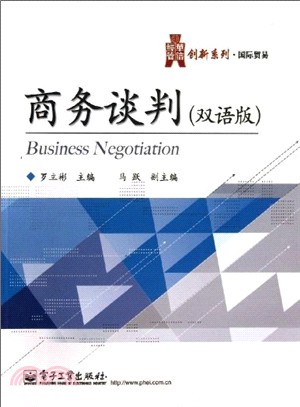商務談判(雙語版)(簡體書)
商品資訊
系列名:華信經管創新系列.國際貿易
ISBN13:9787121214875
出版社:電子工業出版社
作者:羅立彬
出版日:2013/10/01
裝訂/頁數:平裝/220頁
商品簡介
作者簡介
名人/編輯推薦
序
目次
書摘/試閱
相關商品
商品簡介
本教材以商務談判課程的基本框架為依托,系統介紹了商務談判的理論與操作問題,分為四部分:一是商務談判概述;二是商務談判過程;三是商務談判專題;四是國際商務談判。第一部分包括第一章,即商務談判概述;第二部分包括第二章到第五章,包括商務談判的準備、商務談判的開局、商務談判磋商以及商務談判的結束;第三部分包括第六章到第八章,包括商務談判心理、談判力與說服技巧及談判倫理、商務談判過程中的溝通;第四部分包括第九章,介紹文化對商務談判的影響以及各國談判風格
作者簡介
1999---2002 東北財經大學讀碩士(國際貿易專業)
2002至今 北京第二外國語學院國際經濟貿易學院任教
講授市場營銷課兩年(全英語班;中英雙語班)
譯作《消費者行為學》曾獲得2004年度北京第二外國語學院科研三等獎
2002至今 北京第二外國語學院國際經濟貿易學院任教
講授市場營銷課兩年(全英語班;中英雙語班)
譯作《消費者行為學》曾獲得2004年度北京第二外國語學院科研三等獎
名人/編輯推薦
1.體例設計上,參照國外教材惡體例,加入多種案例和專欄,充分考慮學生學習和教師教學的需要;2.加入國際國內最新的研究成果,做到與時俱進,理論與實踐操作并重;3.既介紹了商務談判的理論與原則,又涵蓋了談判過程中涉及的心里、技巧等操作技能
序
前言
商務談判是現代市場經濟中不可或缺的部分,它通過交換信息來強化人們對雙方需求的認知,促成市場交易。好的商務談判可以大大提高市場交易的效率,高效的談判專家可以使談判雙方的需求得到滿足,從而促成“雙贏”的局面。因此,無論從宏觀經濟運行,還是微觀企業運作,再到企業從業人員的職業發展角度,商務談判活動都具備重要的意義。
本教材的編者在編寫此教材時,努力使其形成以下特點:第一,兼顧學生與教師的需要,在體例設計上,參照國外教材的體例,加入多種案例和專欄,充分考慮學生學習和教師教學的需要;第二,在商務談判傳統大綱要求的基礎上,加入國際國內最新的研究成果,做到與時俱進;第三,理論與實踐操作并重,既介紹商務談判的理論與原則,也涵蓋了談判過程中涉及的心理、技巧等操作技能;第三,采用主體用英文,配以中文導讀的形式,更加適合雙語教學。
本教材分為四大部分,即概述、商務談判過程、商務談判專題以及國際商務談判。第1章為商務概述,介紹談判和商務談判的概念、功能、核心要素與分類。第2章到第5章為商務談判過程,是本教材的第二部分。第2章是商務談判的準備,介紹談判背景的調研、談判團隊的組建以及談判的規劃;第3章是商務談判開局,介紹談判開局的目標以及談判氣氛的培養;第4章是商務談判磋商,介紹商務談判過程中發盤、還盤以及各種談判情景下的讓步技巧;第5章為商務談判的結束,介紹選擇結束談判時機的技巧,以及商務合同的注意事項。第6章至第8章是商務談判的專題,是本教材的第三部分,介紹商務談判過程中幾個重要的問題。第6章為商務談判心理,介紹心理因素在商務談判過程中的作用及其把握;第7章為談判力、說服技巧以及談判倫理,介紹談判力的來源,如何利用談判力來說服對方及其過程中涉及的倫理道德問題;第8章為商務談判過程中的溝通,介紹商務談判中的聽、說以及提問等溝通技巧。第9章為本教材的第四部分,即國際商務談判,介紹文化在商務談判中的重要作用以及各國談判風格。
本教材是由兩位教師合作完成的,由羅立彬擔任主編,馬躍擔任副主編。其中第1、6、7、8、9章為羅立彬編寫,第2、3、4、5章由馬躍和羅立彬合作撰寫,最后全書由羅立彬進行統稿。
本書由中英文雙語撰寫,編者本身能力有限,因此書中不準確、不恰當的地方甚至錯誤在所難免,請讀者批評指正。
羅立彬
2013.5.28
商務談判是現代市場經濟中不可或缺的部分,它通過交換信息來強化人們對雙方需求的認知,促成市場交易。好的商務談判可以大大提高市場交易的效率,高效的談判專家可以使談判雙方的需求得到滿足,從而促成“雙贏”的局面。因此,無論從宏觀經濟運行,還是微觀企業運作,再到企業從業人員的職業發展角度,商務談判活動都具備重要的意義。
本教材的編者在編寫此教材時,努力使其形成以下特點:第一,兼顧學生與教師的需要,在體例設計上,參照國外教材的體例,加入多種案例和專欄,充分考慮學生學習和教師教學的需要;第二,在商務談判傳統大綱要求的基礎上,加入國際國內最新的研究成果,做到與時俱進;第三,理論與實踐操作并重,既介紹商務談判的理論與原則,也涵蓋了談判過程中涉及的心理、技巧等操作技能;第三,采用主體用英文,配以中文導讀的形式,更加適合雙語教學。
本教材分為四大部分,即概述、商務談判過程、商務談判專題以及國際商務談判。第1章為商務概述,介紹談判和商務談判的概念、功能、核心要素與分類。第2章到第5章為商務談判過程,是本教材的第二部分。第2章是商務談判的準備,介紹談判背景的調研、談判團隊的組建以及談判的規劃;第3章是商務談判開局,介紹談判開局的目標以及談判氣氛的培養;第4章是商務談判磋商,介紹商務談判過程中發盤、還盤以及各種談判情景下的讓步技巧;第5章為商務談判的結束,介紹選擇結束談判時機的技巧,以及商務合同的注意事項。第6章至第8章是商務談判的專題,是本教材的第三部分,介紹商務談判過程中幾個重要的問題。第6章為商務談判心理,介紹心理因素在商務談判過程中的作用及其把握;第7章為談判力、說服技巧以及談判倫理,介紹談判力的來源,如何利用談判力來說服對方及其過程中涉及的倫理道德問題;第8章為商務談判過程中的溝通,介紹商務談判中的聽、說以及提問等溝通技巧。第9章為本教材的第四部分,即國際商務談判,介紹文化在商務談判中的重要作用以及各國談判風格。
本教材是由兩位教師合作完成的,由羅立彬擔任主編,馬躍擔任副主編。其中第1、6、7、8、9章為羅立彬編寫,第2、3、4、5章由馬躍和羅立彬合作撰寫,最后全書由羅立彬進行統稿。
本書由中英文雙語撰寫,編者本身能力有限,因此書中不準確、不恰當的地方甚至錯誤在所難免,請讀者批評指正。
羅立彬
2013.5.28
目次
Chapter 1 An Introduction to Negotiations(談判概述)
1.1 Negotiation: Definitions, Foundations and Key Factors(談判:定義、基礎和主要要素)
1.1.1 Definitions(談判的定義)
1.1.2 Foundations of Negotiation(談判的基礎)
1.1.3 Key factors in a negotiation(談判的主要要素)
1.2 Classifications of Negotiations(談判的分類)
1.2.1 Different Subjects(不同的談判主題)
1.2.2 Number of Parties(談判方數量不同)
1.2.3 Number of Participants(參與者人數不同)
1.2.4 Differences in Principles (原則不同)
1.2.5 Formality(談判正式性不同)
1.3 Business Negotiation(商務談判)
1.3.1 What is business negotiation?(什么是商務談判)
1.3.2 Characteristics of business negotiations(商務談判的特點)
1.3.3 Principles of Business Negotiations(商務談判的原則)
Key terms
Summary
Chapter 2 Preparations for Business Negotiations(商務談判的準備)
2.1 Researching on Negotiation Background(談判背景調查)
2.1.1 What is Background Information?(什么是背景信息?)
2.1.2 Ways of Information Collection(搜集信息的方式)
2.1.3 Principles in Information Collection(信息收集的原則)
2.2 Finding the Right People to Make a Negotiation Team(尋找組建談判團隊的合適成員)
2.2.1 Different Roles in a Negotiation Team(談判團隊中的不同角色)
2.2.2 Choosing the Right People to Fill Each Role(選擇合適的人員來填補每個角色)
2.3 Negotiation Planning(談判計劃)
2.3.1 Setting the goals that you want to achieve(確定要實現的目標)
2.3.2 Defining the Issues(定義問題)
2.3.3 Determine your walkaway point(確定談判底線)
2.3.4 Know yourself and your negotiating partner(解你自己和你的談判伙伴)
2.3.5 Developing the Negotiation Strategies(制定談判策略)
2.3.6 Working out the Negotiation Plan(制定談判計劃)
2.4 Simulated Negotiation(模擬談判)
2.4.1 Why is Simulated Negotiation Needed?(為什么需要模擬談判?)
2.4.2 Procedures of Simulated Negotiation(模擬談判的程序)
2.4.3 Types of Simulated Negotiation(模擬談判的類型)
Summary
Key Terms
Chapter 3 Opening the Negotiation(談判的開局階段)
3.1 Objectives of the Opening Stage(談判開局階段的目標)
3.1.1 Designing the Opening(設計開局)
3.1.2 Expressing in the Opening(開場陳述)
3.1.3 Realizing the Opening(正式開局)
3.2 Creating the Atmosphere in the Negotiation(營造談判氣氛)
3.2.1 High—spirit Atmosphere(高調氣氛)
3.2.2 Low—spirit Atmosphere(低調氣氛)
3.2.3 Natural Atmosphere(自然氣氛)
Summary
Key Terms
Chapter 4 Bargaining in Business Negotiations(商務談判的磋商階段)
4.1 Quoting Prices(發盤)
4.1.1 Definition of Quotation(發盤的定義)
4.1.2 Principles in Quoting Prices(發盤的原則)
4.1.3 Should I be the first to quote?(我應該率先報價嗎?)
4.2 Counter—Quotation(還盤)
4.3 Concession making in different situations(不同情況下的讓步)
4.3.1 Concession making in tacit coordination and relationship situations(在默契配合關系下做出讓步)
4.3.2 Concession making in transactions: distributive bargaining and integrative bargaining(交易中的讓步:分配式談判和整合式談判)
4.3.3 Concession making in balanced concerns(在平衡的基礎上做出讓步)
Summary
Key Terms
Chapter 5 Conclusion of the Business Negotiation(結束商務談判)
5.1 Concluding the Business Negotiation(結束商務談判)
5.1.1 Finding the Right Time to Conclude the Business Negotiation(結束商務談判的正確時間)
5.1.2 Points to Consider When Concluding the Business Negotiation(結束商務談判時需要考慮的因素)
5.1.3 Possible Results of the Business Negotiation(商務談判的結果)
5.2 Entering into a Business Contract(簽訂合同)
5.2.1 What Is a Business Contract?(什么是商務合同)
5.2.2 Structure of a Business Contract(商務合同的結構)
5.2.3 Major Clauses in a Business Contract(商務合同的主要條款)
Summary
Key Terms
Chapter 6 Psychology in Business Negotiations(商務談判中的心理學)
6.1 Negotiations are not always rational(談判并非都是理性的)
6.1.1 Cognitive Bias(認知偏差)
6.1.2 Motivational Bias(激勵偏差)
6.2 Confronting Psychological Biases(應對心理偏差)
6.2.1 Use ”System 2” Thinking(采用“系統2”思維)
6.2.2 Learn Through the Use of Analogies(通過類比使用進行學習)
6.2.3 Adopt the Outsider Lens(選擇局外人的角度)
6.3 Confronting the Psychological Biases of Others(應對他人的心理偏差)
6.3.1 Incorporate the Consequences of Their Biases in Your Strategy
(在策略中結合對方偏差的后果)
6.3.2 Help Others be Less Biased(幫助別人減少偏見)
6.3.3 Calibrate Information Provided by Others(校準由他人提供的信息)
6.3.4 Use Contingency Contracts to Resolve Conflicts Stemming from Biases(使用應急合同來解決源自于偏差的沖突)
Summary
Key terms
Chapter 7 Negotiation Power, Persuasion and Ethics(談判力、說服策略與談判論理)
7.1 Sources of Negotiation Power(談判力的來源)
7.1.1 Informational Power(信息性談判力)
7.1.2 Legitimate Power(法定談判力)
7.1.3 Relationship—based Power(以關系為基礎的談判力)
7.1.4 Time Power(以時間為基礎的談判力)
7.1.5 Contextual Power(背景性談判力)
7.1.6 Free Sources of Power(免費的談判力來源)
7.2 How to Persuade Your Counterparty for Your Favor?(如何說服對方)
7.2.1 Central Route Tactics(中央路徑的策略)
7.2.2 Peripheral Route Tactics(外圍路徑策略)
7.3 Negotiation Ethics(談判倫理)
7.3.1 Schools of Attitudes toward Lying(關于說謊的態度)
7.3.2 How to determine whether your behavior is ethical or not?(如何確定你的行為是否符合倫理?)
7.3.3 Dealing with Unethical Negotiators(應對不符合倫理的談判者)
Summary
Key terms
Chapter 8 Communications in Negotiation(談判溝通)
8.1 Essentials of Communications in Business negotiations(商務談判中的溝通實質)
8.1.1 Concept of Communications in Business Negotiations(商務談判中溝通概念)
8.1.2 Four key elements of a communication(溝通的四個關鍵要素)
8.1.2 Characteristics of Communications in Business Negotiations(商務談判中的溝通特點)
8.2 Effective Communications in a Business Negotiation(商務談判中的有效溝通)
8.2.1 Advantages and characteristics of effective communication(有效溝通的優勢及特點)
8.2.2 Communication barriers(溝通障礙)
8.2.3 Overcoming Communication Barriers in a Negotiation(克服談判中的溝通障礙)
8.3 Effective Listening during Business Negotiations (商務談判過程中的有效傾聽)
8.3.1 What can effective listening do for you?(有效傾聽能為你做什么?)
8.3.2 Barriers to Effective Listening(有效傾聽的障礙)
8.3.3 Characteristics of Good and Effective Listener(好的、有效的傾聽者的特點)
8.4 Raising Questions during Business Negotiations(在商務談判的過程中提出問題)
8.4.1 Why do we raise questions during business negotiations?(為什么要在商務談判的過程中提出問題?)
8.4.2 Skills of raising question(提問題的技巧)
8.5 Some useful speaking skills(一些有用的演講技巧)
Summary
Key terms
Chapter 9 Culture Dimensions and Negotiation Styles in Different Countries(不同國家的文化維度和談判風格)
9.1 Culture: Definitions and Dimensions(文化:定義和維度)
9.1.1 Behaviors and Institutions(行為方式和制度)
9.1.2 Some important cultural traits for negotiations(對談判而言非常重要的一些文化特性)
9.1.3 Negotiation Styles in Different Countries(不同國家的談判風格)
9.2 Strategies for Intercultural Negotiations(跨文化談判策略)
9.2.1 Adhering(堅持)
9.2.2 Avoiding—Contending(回避——斗爭)
9.2.3 Adapting(適應)
9.2.4 Adopting(采用)
9.2.5 Advancing(前進)
Summary
Key terms
Refefences
1.1 Negotiation: Definitions, Foundations and Key Factors(談判:定義、基礎和主要要素)
1.1.1 Definitions(談判的定義)
1.1.2 Foundations of Negotiation(談判的基礎)
1.1.3 Key factors in a negotiation(談判的主要要素)
1.2 Classifications of Negotiations(談判的分類)
1.2.1 Different Subjects(不同的談判主題)
1.2.2 Number of Parties(談判方數量不同)
1.2.3 Number of Participants(參與者人數不同)
1.2.4 Differences in Principles (原則不同)
1.2.5 Formality(談判正式性不同)
1.3 Business Negotiation(商務談判)
1.3.1 What is business negotiation?(什么是商務談判)
1.3.2 Characteristics of business negotiations(商務談判的特點)
1.3.3 Principles of Business Negotiations(商務談判的原則)
Key terms
Summary
Chapter 2 Preparations for Business Negotiations(商務談判的準備)
2.1 Researching on Negotiation Background(談判背景調查)
2.1.1 What is Background Information?(什么是背景信息?)
2.1.2 Ways of Information Collection(搜集信息的方式)
2.1.3 Principles in Information Collection(信息收集的原則)
2.2 Finding the Right People to Make a Negotiation Team(尋找組建談判團隊的合適成員)
2.2.1 Different Roles in a Negotiation Team(談判團隊中的不同角色)
2.2.2 Choosing the Right People to Fill Each Role(選擇合適的人員來填補每個角色)
2.3 Negotiation Planning(談判計劃)
2.3.1 Setting the goals that you want to achieve(確定要實現的目標)
2.3.2 Defining the Issues(定義問題)
2.3.3 Determine your walkaway point(確定談判底線)
2.3.4 Know yourself and your negotiating partner(解你自己和你的談判伙伴)
2.3.5 Developing the Negotiation Strategies(制定談判策略)
2.3.6 Working out the Negotiation Plan(制定談判計劃)
2.4 Simulated Negotiation(模擬談判)
2.4.1 Why is Simulated Negotiation Needed?(為什么需要模擬談判?)
2.4.2 Procedures of Simulated Negotiation(模擬談判的程序)
2.4.3 Types of Simulated Negotiation(模擬談判的類型)
Summary
Key Terms
Chapter 3 Opening the Negotiation(談判的開局階段)
3.1 Objectives of the Opening Stage(談判開局階段的目標)
3.1.1 Designing the Opening(設計開局)
3.1.2 Expressing in the Opening(開場陳述)
3.1.3 Realizing the Opening(正式開局)
3.2 Creating the Atmosphere in the Negotiation(營造談判氣氛)
3.2.1 High—spirit Atmosphere(高調氣氛)
3.2.2 Low—spirit Atmosphere(低調氣氛)
3.2.3 Natural Atmosphere(自然氣氛)
Summary
Key Terms
Chapter 4 Bargaining in Business Negotiations(商務談判的磋商階段)
4.1 Quoting Prices(發盤)
4.1.1 Definition of Quotation(發盤的定義)
4.1.2 Principles in Quoting Prices(發盤的原則)
4.1.3 Should I be the first to quote?(我應該率先報價嗎?)
4.2 Counter—Quotation(還盤)
4.3 Concession making in different situations(不同情況下的讓步)
4.3.1 Concession making in tacit coordination and relationship situations(在默契配合關系下做出讓步)
4.3.2 Concession making in transactions: distributive bargaining and integrative bargaining(交易中的讓步:分配式談判和整合式談判)
4.3.3 Concession making in balanced concerns(在平衡的基礎上做出讓步)
Summary
Key Terms
Chapter 5 Conclusion of the Business Negotiation(結束商務談判)
5.1 Concluding the Business Negotiation(結束商務談判)
5.1.1 Finding the Right Time to Conclude the Business Negotiation(結束商務談判的正確時間)
5.1.2 Points to Consider When Concluding the Business Negotiation(結束商務談判時需要考慮的因素)
5.1.3 Possible Results of the Business Negotiation(商務談判的結果)
5.2 Entering into a Business Contract(簽訂合同)
5.2.1 What Is a Business Contract?(什么是商務合同)
5.2.2 Structure of a Business Contract(商務合同的結構)
5.2.3 Major Clauses in a Business Contract(商務合同的主要條款)
Summary
Key Terms
Chapter 6 Psychology in Business Negotiations(商務談判中的心理學)
6.1 Negotiations are not always rational(談判并非都是理性的)
6.1.1 Cognitive Bias(認知偏差)
6.1.2 Motivational Bias(激勵偏差)
6.2 Confronting Psychological Biases(應對心理偏差)
6.2.1 Use ”System 2” Thinking(采用“系統2”思維)
6.2.2 Learn Through the Use of Analogies(通過類比使用進行學習)
6.2.3 Adopt the Outsider Lens(選擇局外人的角度)
6.3 Confronting the Psychological Biases of Others(應對他人的心理偏差)
6.3.1 Incorporate the Consequences of Their Biases in Your Strategy
(在策略中結合對方偏差的后果)
6.3.2 Help Others be Less Biased(幫助別人減少偏見)
6.3.3 Calibrate Information Provided by Others(校準由他人提供的信息)
6.3.4 Use Contingency Contracts to Resolve Conflicts Stemming from Biases(使用應急合同來解決源自于偏差的沖突)
Summary
Key terms
Chapter 7 Negotiation Power, Persuasion and Ethics(談判力、說服策略與談判論理)
7.1 Sources of Negotiation Power(談判力的來源)
7.1.1 Informational Power(信息性談判力)
7.1.2 Legitimate Power(法定談判力)
7.1.3 Relationship—based Power(以關系為基礎的談判力)
7.1.4 Time Power(以時間為基礎的談判力)
7.1.5 Contextual Power(背景性談判力)
7.1.6 Free Sources of Power(免費的談判力來源)
7.2 How to Persuade Your Counterparty for Your Favor?(如何說服對方)
7.2.1 Central Route Tactics(中央路徑的策略)
7.2.2 Peripheral Route Tactics(外圍路徑策略)
7.3 Negotiation Ethics(談判倫理)
7.3.1 Schools of Attitudes toward Lying(關于說謊的態度)
7.3.2 How to determine whether your behavior is ethical or not?(如何確定你的行為是否符合倫理?)
7.3.3 Dealing with Unethical Negotiators(應對不符合倫理的談判者)
Summary
Key terms
Chapter 8 Communications in Negotiation(談判溝通)
8.1 Essentials of Communications in Business negotiations(商務談判中的溝通實質)
8.1.1 Concept of Communications in Business Negotiations(商務談判中溝通概念)
8.1.2 Four key elements of a communication(溝通的四個關鍵要素)
8.1.2 Characteristics of Communications in Business Negotiations(商務談判中的溝通特點)
8.2 Effective Communications in a Business Negotiation(商務談判中的有效溝通)
8.2.1 Advantages and characteristics of effective communication(有效溝通的優勢及特點)
8.2.2 Communication barriers(溝通障礙)
8.2.3 Overcoming Communication Barriers in a Negotiation(克服談判中的溝通障礙)
8.3 Effective Listening during Business Negotiations (商務談判過程中的有效傾聽)
8.3.1 What can effective listening do for you?(有效傾聽能為你做什么?)
8.3.2 Barriers to Effective Listening(有效傾聽的障礙)
8.3.3 Characteristics of Good and Effective Listener(好的、有效的傾聽者的特點)
8.4 Raising Questions during Business Negotiations(在商務談判的過程中提出問題)
8.4.1 Why do we raise questions during business negotiations?(為什么要在商務談判的過程中提出問題?)
8.4.2 Skills of raising question(提問題的技巧)
8.5 Some useful speaking skills(一些有用的演講技巧)
Summary
Key terms
Chapter 9 Culture Dimensions and Negotiation Styles in Different Countries(不同國家的文化維度和談判風格)
9.1 Culture: Definitions and Dimensions(文化:定義和維度)
9.1.1 Behaviors and Institutions(行為方式和制度)
9.1.2 Some important cultural traits for negotiations(對談判而言非常重要的一些文化特性)
9.1.3 Negotiation Styles in Different Countries(不同國家的談判風格)
9.2 Strategies for Intercultural Negotiations(跨文化談判策略)
9.2.1 Adhering(堅持)
9.2.2 Avoiding—Contending(回避——斗爭)
9.2.3 Adapting(適應)
9.2.4 Adopting(采用)
9.2.5 Advancing(前進)
Summary
Key terms
Refefences
書摘/試閱
3.2Creating Atmosphere in a Negotiation
(營造談判氣氛)
Negotiation atmosphere refers to the climate and the surroundings that one or both parties have created before the negotiation has begun, which can reflect the frankness, national characteristics, cultural attributes, choice of styles and psychological implications.
Negotiation atmosphere affects and is affected by the kinds of experiences the parties have had with each other, the relationships established and the climate of trustworthiness created.Equally it affects and is affected by the market environment where the market is such that a switch of commitment to another organization is difficult and costly, considerable resources may have to be put into the relationship.
Negotiation atmosphere is of prime importance.Good negotiation atmosphere will facilitate the smooth development of the negotiation; on the other hand, bad negotiation atmosphere will have an adverse impact on the course of the negotiation or even destroy the whole negotiation.The main purpose of business negotiation is should be the biggest profit; therefore, the negotiation atmosphere should be positive, friendly and constructive.However, some negotiations are aimed to solve the intricate trade conflicts or hope to force the other party to make concessions.Under these conflicting circumstances, negotiation atmosphere tends to be tense and contradictory.
主題書展
更多
主題書展
更多書展今日66折
您曾經瀏覽過的商品
購物須知
大陸出版品因裝訂品質及貨運條件與台灣出版品落差甚大,除封面破損、內頁脫落等較嚴重的狀態,其餘商品將正常出貨。
特別提醒:部分書籍附贈之內容(如音頻mp3或影片dvd等)已無實體光碟提供,需以QR CODE 連結至當地網站註冊“並通過驗證程序”,方可下載使用。
無現貨庫存之簡體書,將向海外調貨:
海外有庫存之書籍,等候約45個工作天;
海外無庫存之書籍,平均作業時間約60個工作天,然不保證確定可調到貨,尚請見諒。
為了保護您的權益,「三民網路書店」提供會員七日商品鑑賞期(收到商品為起始日)。
若要辦理退貨,請在商品鑑賞期內寄回,且商品必須是全新狀態與完整包裝(商品、附件、發票、隨貨贈品等)否則恕不接受退貨。
優惠價:87
172
海外經銷商無庫存,到貨日平均30天至45天
























